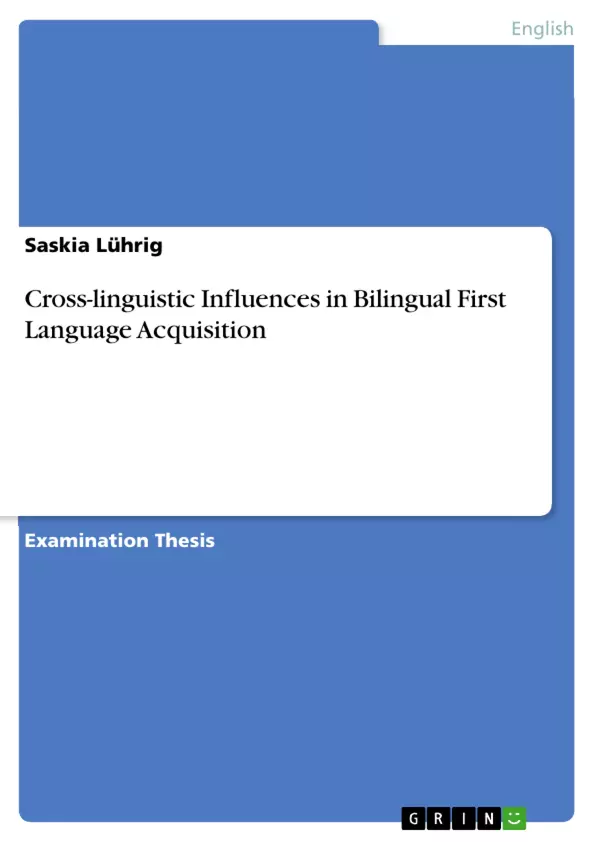There is interdependent development in BFLA. Several studies could show that the systems are influencing each other and they can not be regarded as minor to argue for an autonomous development. Furthermore, there are different methods of predicting which grammatical domains will be influenced and the direction of influence. These are language internal factors, dominance or epiphenomena of speech production. Nevertheless, there are problems as some children did not show the predicted influence. Possible suggestion to the problem is a modification of the criteria already developed and an inclusion of the possibility of individual differences due to different learner types.
Inhaltsverzeichnis (Table of Contents)
- 1 Introduction
- 2 Definitions, Terminology and Concepts on BFLA
- 2.1 Definition of BFLA
- 2.2 Factors Determining BFLA: Age, Input, Access to UG
- 2.3 Concepts and Theories on BFLA
- 3 Interdependent Development - Cross-Linguistic Influences in BFLA
- 3.1 Cross-Linguistic Influences: Definition
- 3.2 Predicting CLI
- 4 Empirical Studies showing CLI
- 4.1 Transfer
- 4.1.1 Word Order in Subordinate Clauses in French/Italian-German Bilinguals
- 4.1.2 Wh-Interrogatives in a Cantonese-English Bilingual
- 4.1.3 Wh-interrogatives in English-Japanese Bilinguals
- 4.2 Acceleration
- 4.2.1 Determiners in German-French and German-Italian Bilinguals
- 4.2.2 Verb Position in Main Clauses in German-Italian Bilinguals
- 4.3 Delay
- 4.3.1 Subject drop in German-Italian Bilinguals
- 4.3.2 Object drop in German-Italian and German-French Bilinguals
- 5 Interpretation of the Results and Theoretical Implications
- 5.1 Methodology
- 5.2 Discussion of Results: Cross-linguistic Influences - Language-internal vs. Language-external Factors
- 5.3 General Implications on Language Acquisition
Zielsetzung und Themenschwerpunkte (Objectives and Key Themes)
This paper aims to demonstrate the existence of cross-linguistic influences on bilingual first language acquisition (BFLA) competence and to explain these influences through a combination of language-internal and language-external factors. It challenges previous assumptions of autonomous development in BFLA, arguing instead for interdependent development.
- Definitions and theories of BFLA, including the role of age, input, and access to Universal Grammar (UG).
- The nature and prediction of cross-linguistic influences (CLI) in BFLA.
- Empirical evidence for CLI, examining transfer, acceleration, and delay in various bilingual populations.
- The role of language-internal and language-external factors in shaping CLI.
- Implications of CLI findings for broader theories of language acquisition.
Zusammenfassung der Kapitel (Chapter Summaries)
Chapter 1: Introduction introduces the increasing prevalence of bilingualism and the evolving understanding of BFLA, contrasting the Single System Hypothesis and Autonomous Development with the concept of Interdependent Development.
Chapter 2: Definitions, Terminology and Concepts on BFLA defines BFLA and examines factors influencing its development, including age of exposure, language input, and access to UG. It also reviews differing theoretical approaches to the relationship between the two languages in a bilingual child's mind.
Chapter 3: Interdependent Development - Cross-Linguistic Influences in BFLA defines cross-linguistic influences and discusses methodologies for predicting their occurrence and the language(s) involved.
Chapter 4: Empirical Studies showing CLI presents several studies demonstrating transfer, acceleration, and delay in various bilingual groups. Specific examples include word order in subordinate clauses, wh-interrogatives, determiner usage, and verb placement.
Schlüsselwörter (Keywords)
Bilingual first language acquisition (BFLA), cross-linguistic influences (CLI), transfer, acceleration, delay, interdependent development, autonomous development, Universal Grammar (UG), language-internal factors, language-external factors, morphosyntax.
- Arbeit zitieren
- Saskia Lührig (Autor:in), 2007, Cross-linguistic Influences in Bilingual First Language Acquisition, München, GRIN Verlag, https://www.grin.com/document/123443



